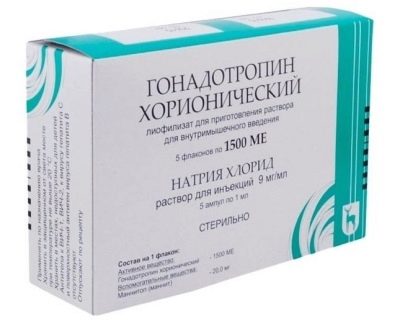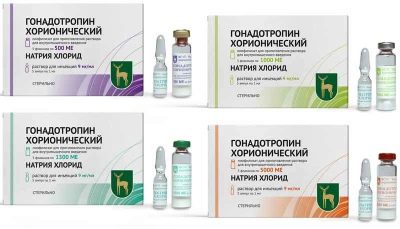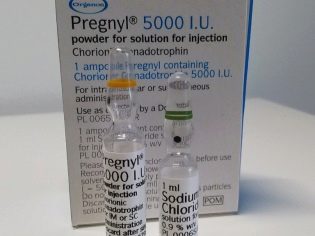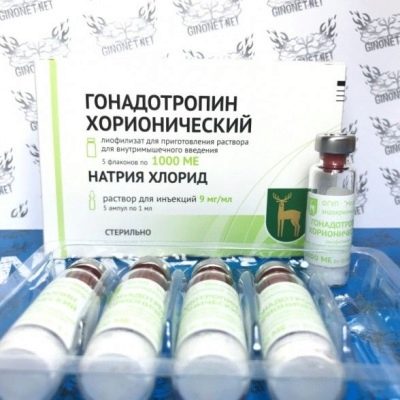Chorionic gonadotropin: instructions for use of the drug in injections to stimulate ovulation and maintain pregnancy
Chorionic gonadotropin is a unique hormone that allows the embryo to develop and gives a woman a chance to become a mother. It is produced by the tissue of the chorion - the fetal membrane immediately after the fertilized egg is lowered into the uterine cavity and fixed there. A special drug with the same name is also a chance to experience the joy of motherhood for those who conceive with problems. How the tool is used and what results it gives, we will tell in this article.
What is it - the drug and analogues
"Chorionic gonadotropin" - a medicine that is obtained from the urine of pregnant women. The hormone enters the secreted fluid from the blood, which in turn is enriched with this substance during pregnancy. The hormonal substance is produced almost unchanged, which is why it is so easily extracted from the urine of expectant mothers.
In our country, the medicine can be purchased both local and Russian, as well as its imported counterparts - Pregnil, Profazi, Khoragon. All drugs containing hCG are prescribed by a doctor according to individual indications, unauthorized treatment by them is strictly prohibited, as it can lead to the strongest hormonal imbalance in the human body.
As the name suggests, the main active ingredient of the drug is human chorionic gonadotropin. In the future mother's body, the most important functions are assigned to him - to stimulate the corpus luteum, which is formed after ovulation, help develop large amounts of progesterone and estrogen, save the embryo and create the most comfortable conditions for it.
Partially gonadotropic hormone inhibits the aggression of maternal immunity. Without this, a woman’s immune defenses would simply reject a fetus that has in its DNA 50% of the alien chains inherited from the father.
The strong effect of the main substance is used for a wide variety of medical purposes. The drug injections is prescribed to women, men and adolescents. However, the drug is most often used in gynecology and obstetrics.
Act
Chorionic gonadotropin is directly involved in the synthesis of sex hormones in both men and women. This substance significantly improves the process of production of substances in the testicles in the stronger sex and in the ovaries in women. It affects the key "event" of the female cycle - it is this hormonal drug used to stimulate ovulation, if for some reason it does not occur in a woman herself, anovulatory cycles take place.
After ovulation has occurred, the drug helps to maintain the function of the corpus luteum - the follicle, which produces hormones important for the onset of pregnancy - progesterone and estrogens. Under the influence of gonadotropic hormone, the genitals of both men and women develop correctly, and secondary sexual characteristics are normally formed.
Due to the broad spectrum of the drug, fertility specialists and obstetricians are very appreciated.It allows you not only to get pregnant, but also to support a “problem” pregnancy, which without hormone therapy will most likely end in miscarriage or premature birth.
Who is prescribed the drug?
Injections of hCG are recommended for all women and men seeking medical attention with gutters to reduce sexual function. This includes weak sexual desire, and the inability to become pregnant on their own, and problems with reproductive functions in men.
The drug is shown to people suffering from hypoplasia of the genital organs, insufficiency of reproductive abilities, dwarfism, disorders of the pituitary and hypothalamus, due to which hormonal disturbances are disturbed. The tool is widely used in adolescence, if there is a delay in sexual development.
In gynecological practice, the drug is prescribed:
women with dysmenorrhea (severe pain during menstruation, additional unpleasant symptoms of “critical” days - nausea, vomiting, headaches, dizziness, loss of consciousness);
women with ovarian dysfunction;
women with infertility associated with a lack of ovulation in the cycle;
women who cannot become pregnant due to a lack of yellow body;
patients to stimulate ovulation before embryo transfer by the IVF method, as well as after embryo transfer to maintain pregnancy;
patients who have already had several miscarriages, especially in the early stages (habitual miscarriage);
pregnant women with pronounced signs of threatened interruption.
The indication for the use of the drug are also hereditary problems with reproductive function in women and men.
Who is contraindicated?
In some cases, the use of the drug will have to be abandoned, because it has a fairly large list of contraindications. So, "Chorionic gonadotropin" can not be used for:
hypersensitivity to this hormone that can be the beginning of the strongest allergic reaction;
in ovarian carcinoma, cancer of the reproductive gland in women;
with tumors and tumors in the pituitary gland;
with the so-called hormonal tumors in the body, which are able to respond with rapid growth to the introduction of androgens;
with insufficient thyroid function;
with adrenal dysfunction or insufficiency;
with an increased level of the hormone prolactin in the patient's blood;
at the come menopause, a climax;
with epilepsy;
with obstruction of the fallopian tubes, with a strong adhesive process in them;
during breastfeeding;
with diagnosed thrombophlebitis.
With increased precautions, medication is prescribed for women with coronary heart disease, high blood pressure, renal failure, both acute and chronic, suffering from bronchial asthma.
Side effects
Like any hormonal drug, "Chorionic gonadotropin" can cause an allergic reaction. Usually it is local, redness, slight swelling and mild itching are observed only at the injection site. Much more often the drug causes headaches. Many women complain that they feel “broken”, constantly tired, some even have depression.
If the drug is used in combination with other agents as part of complex therapy for reproductive techniques, for example, with Clomiphene, ovarian hyperstimulation syndrome may develop when ovaries form cysts dangerous from the point of view of the possibility of their sudden rupture. At the same time, the appearance of fluid in the abdominal cavity and chest cavity is not excluded.
Sometimes women complain of swelling, mood swings, uncontrolled bouts of aggression. All this - the result of the impact of the hormone on the brain.It is not necessary that each patient will experience the indicated side effects from taking the drug, but everyone should be aware of the possible consequences.
Instructions for use - dosage
The drug is available in powder form, from which you can prepare a solution for injection. The box also has an isotonic solution of sodium chloride for this. Therefore, the preparation of ready-to-use means of labor will not be. Introduce medication exclusively intramuscularly.
The dosage depends on the purpose of the drug. Women who are going to IVF or to stimulate ovulation, are administered one-time 5000-10000 IU of the drug. If the treatment is carried out with the use of other means, then it is important that the last menotropin intake be for at least one day, and from the last administration of Clomiphene for at least five days.
If the patient has found insufficient functioning of the corpus luteum, then the optimal dosage for her is 1500 IU. An injection is given every two days up to the moment when either the menstruation begins, or the test confirms the long-awaited pregnancy. The first injection is made on the day of ovulation.
The solution for injection is prepared immediately before the procedure, you should not do this in advance. Dosages of the active substance in the packages offered on the counters of pharmacists - 500 units, 1000 units, 1500 units, 5000 units. The doctor will tell you the most appropriate form, since the treatment must necessarily take place under the supervision of an experienced specialist.
Application to stimulate ovulation
Ovulation is the release of a mature and finished egg from a mature follicle. It usually occurs in the middle of a cycle. For various reasons, the egg may be weakened, against the background of a lack of female hormones, it may not make a timely exit or not mature. That is why infertility treatment often begins with stimulating healthy and normal ovulation.
This method allows you to achieve success in about 70-75% of cases, if everything is done correctly and there are no contraindications for the use of "human chorionic gonadotropin". An important condition is the integrity of the egg. It should not be damaged. For this stimulation is preceded by a thorough examination. As part of the diagnostics, doctors check the state of the hormonal background of a woman who dreams of motherhood, examine the health of her reproductive system, find out if the fallopian tubes are permeable, whether there are adhesions, and ovarian cysts.
If these pathologies are not present, then complex therapy is applied. After menstruation, Klostilbegit is prescribed to a woman and she should take it until the 9th day of the cycle.
Then do ultrasound, which establish the size and number of follicles. As soon as one of them reaches the desired size, you can make a hCG angle. The drug is administered at a follicle size of 17 millimeters (preferably 19-22 mm). To do this, often use the imported drug "Pregnil", it is well established.
Thus, Klostilbegit helps to prepare the egg for release, and gonadotropin contributes to the rupture of the follicle and the release of the egg. Dosages and treatment regimen are assigned to each patient individually, because each woman has her own reasons for infertility, her own particular menstrual cycle. The prescribed course can be corrected if, on intermediate ultrasounds, it turns out that the therapy is ineffective, that symptoms of superovulation appear - cysts on the ovaries. The task of the doctor in this situation is to prevent their rupture, for this hormone treatment is canceled.
Many women who have to stimulate ovulation, are wondering how long after the injection ovulation occurs. The answer to this question is given by manufacturers of the drug produced in Russia.The official instructions for use of the drug indicate that the long-awaited moment after the injection comes in 32-36 hours. Import manufacturers have an identical interval.
It is not necessary that the angle will be single. As stated above, the dosage for one injection is from 5,000 to 10,000 units, but there may be up to three injections themselves. It all depends on how the female body reacts to the hormonal attack, and whether it is possible to achieve the desired state of the follicle for conception. With IVF, ovulation is stimulated with a single dose of 10,000 units. Injections into the abdomen with a short needle (from an insulin syringe) are considered to be the most effective; this intramuscular method of drug administration is most often used.
For more successful planning, during the preparation and conduct of ovulation stimulation, it is recommended that women donate blood for progesterone and estradiol, measure the baseline temperature daily, and observe the sexuality regimen prescribed by the attending doctor.
Tests after the injection
Special attention should be paid to the use of various tests after hormonal therapy with hCG preparations. The level of the hormone obtained by the female body "from outside", of course, affects the results and tests that can be carried out later. Therefore, an ovulation test is recommended to be done not earlier than in three days, and a pregnancy test after the injection will not be informative for at least 12 days. Most often, a woman will see the second strip, but the result will be false positive.
The concentration of the hormone produced during the injection leaves the body in about 12 days. Therefore, doctors do not recommend buying pharmacy tests before the fifteenth day after ovulation. The best option is considered a blood test for hCG. If you do it several times, the dynamics will be noticeable. Positive if the pregnancy has come, and negative (the level will decrease) if the conception did not take place.
Application to maintain pregnancy
Lack of proper chorionic gonadotropin in the first place is manifested by a high probability of miscarriage in the early period. Lack of this hormone leads to insufficient production of progesterone - the hormone "responsible" for the preservation of pregnancy. Therefore, low levels of hCG can lead to fetal death of the embryo and missed abortion.
If a woman has already had a pregnancy earlier in this scenario, she is more likely to be offered hormone therapy “Chorionic gonadotropin”. If a woman suffers from habitual miscarriage, then she is recommended to identify the fact of pregnancy as soon as possible using modern diagnostic methods and start treatment with this drug or its equivalent in time.
It is important that the first injections during pregnancy in the early stages were held before the 8th obstetric week and ended by the 14th week. This also applies to cases when a woman first appears to have symptoms of an early threat of spontaneous abortion.
Dosage depending on the type of pathology ranges from 1000 to 3000 units. Injections are made every two days, after 10 weeks - every 3-4 days up to 14 weeks, when the threat is considered to have been successfully completed.
If the problem of miscarriage is due to improper operation or dysfunction of the corpus luteum, the dosage may be from 1,500 to 5,000 units for one injection. If habitual miscarriage is caused by immune or hormonal causes, then the first dose will be 10,000 units, and the next dose will be 5,000 units. In case of miscarriages of unclear etiology, the reasons for which could not be established, any dosage can be assigned, except for 10,000, this question is decided by the attending physician, based on the results of biochemical blood analysis.
In the course of a long course of treatment, the woman will have to follow other recommendations, without which hormone therapy may be ineffective.She will have to visit the gynecologist more often, do an ultrasound more often to monitor the condition of the cervix and cervical canal, and also to monitor the growth and development of the embryo, to donate blood for hormones and biochemical analysis several times. With a serious threat, hospital stays are recommended.
If problems with conception and childbirth are associated with endometriosis, the doctor may prescribe hormone agonists of gonadotropin - releasing hormone. Women should understand that such drugs do not work on the ability to conceive a child, they only help to prepare a woman’s body for further attempts to conceive a baby, to help cope with endometriosis.
special instructions
It is a mistake to believe that a single injection of hCG during ovulation stimulation will help to cure a woman from anovulation. The drug only stimulates the release of a single egg in a particular cycle. The effect of the drug does not apply to other cycles.
Agreeing to treatment with this hormonal drug, a woman should be aware of the consequences of gonadotropic therapy, such as multiple pregnancy. Often, a woman who is stimulated by ovulation with a large dosage of hCG (10,000 units) eventually becomes a happy future mother not of one, but of two or three babies at once.
Many women complain that the lower abdomen hurts after an injection. This should not scare, because the hormonal injection is quite painful, gradually these post-traumatic pains will pass.
If you take the drug human chorionic gonadotropin for too long, then the body can produce antibodies that will interfere with the development of this useful and necessary in certain situations, the substance. This will greatly complicate future pregnancies, make conception and carrying a child practically impossible.
Both the original drug and its foreign analogues are not recommended to be combined with alcohol and narcotic drugs. The question of the compatibility of the hormone with alcohol, which often sounds in many women's forums, generally raises a reasonable answer about the inadmissibility of alcohol during the planning period in general, with the auxiliary reproductive technique in particular.
How to do injections?
Given that the course of treatment is long, and not all future moms live next to a medical facility, where you can apply for an injection, the question arises how to make an injection of hCG on your own. In fact, it is not difficult if you follow the whole sequence of actions:
Wash your hands well with soap and water. It is better to use soap with antibacterial action.
Ampoule with an isotonic solution of sodium chloride opens first.
A syringe from her recruited content in full.
The isotonic solution is introduced into the ampoule with the preparation's powder and mixes well until it is evenly distributed without precipitating. You need to stir in a circular motion and in no case shake the vial.
The finished solution is collected in a syringe, change the needle to the usual, if you decide to prick the buttock or on a small "insulin", if you plan to make an injection in the stomach.
Cotton wool soaked in alcohol or special pharmacy alcohol wipes wipe the injection site.
The drug is administered intramuscularly, not quickly.
After the injection, an alcohol wipe is applied to the injection site and lightly pressed for 1-2 minutes.
The method of administering the drug in the stomach is most often used when stimulating ovulation. For systematic use of the schedule while preserving pregnancy, it is better to prick chorionic gonadotropin into the gluteus.
Overdose symptoms
An overdose of a hormone can manifest with ovarian hyperstimulation. The appearance of a cyst on the genital gland may indicate a worsening state of health of a woman. There may be a sharp pain in the lower abdomen, nausea, vomiting. The pain occasionally "shoots" in the groin area.Many women with acute overstimulation syndrome have a feeling of distention of the intestine, distention.
The occurrence of diarrhea is not excluded, but at the same time the number of urination decreases, the woman begins swelling of the lower extremities and hands, breathing becomes more frequent.
In more severe cases, a woman's blood clotting is disturbed - the blood becomes thicker, peritonitis and acute pulmonary insufficiency can develop. A woman should immediately seek medical attention, temporarily discontinue the drug and undergo symptomatic treatment aimed at reducing and disappearing cysts, restoring water-salt and mineral balance, as well as therapy to normalize blood clotting.
Storage conditions and leave from pharmacies
The drug belongs to the pharmacological group B, it can be bought in pharmacies only by prescription. Store boxes with a solution and dry powder for breeding should be at a temperature not higher than 20 degrees heat, so that direct sunlight does not fall on the medication.
If a diluted solution remains after the injection, it is impossible to reuse it, it is advisable to prepare a new portion of the solution for a new injection, and you do not need to store the remains at all, either in the medicine cabinet or in the refrigerator.
Reviews
Many women in their reviews indicate that this particular drug helped them to become pregnant, gave a chance to experience the real joy of motherhood. Most of these patients were already treated with progesterone and other hormonal drugs in previous pregnancies, but to no avail - there were miscarriages or the pregnancy stopped developing.
Many become mothers claim that the drug could act not from the first, but from the second or third time, but, compared to the planning years, 2-3 months did not seem to them for a long time. Among the shortcomings of the woman indicate the high cost of the drug, as of December 2017, the following rates for the original means are considered relevant:
drug packaging at a dosage of 500 IU (5 ampoules + solution) - from 500 rubles;
packing “Chorionic gonadotropin” in a dosage of 1000 U (5 ampoules + solution) - from 750 rubles;
drug packaging in the dosage of 5000 IU (5 ampoules + solution) - from 3200 rubles.
According to the women who left their feedback on the drug on the Internet, such packaging (5 ampoules) is not very convenient for use, because some do not need more than one or two shots. As a result, the remaining vials remain unclaimed.
The drug is withdrawn within 2 weeks, many pregnancy tests show reliable results after 2-3 days of delay from the day of the alleged menstruation, which, fortunately, has not started.
With regard to another use of the drug - to maintain pregnancy, the responses are also mostly positive.
















































